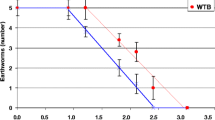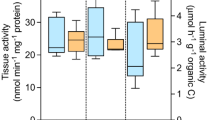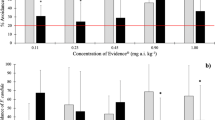Abstract
The avoidance response of earthworms to polluted soils has been standardised using a simple and low-cost test, which facilitates soil toxicity screening. In this study, the avoidance response of Lumbricus terrestris was quantified in chlorpyrifos-spiked soils, depending on the pesticide concentration and exposure duration. The inhibition of acetylcholinesterase (AChE) and carboxylesterase (CbE) activities was also determined as indirect measures of pesticide bioavailability. The effects of different chlorpyrifos concentrations were examined in a standardised test (two-chamber system) with 0.6, 3 and 15 mg/kg chlorpyrifos. A modification of the test involved a pre-exposure step (24, 48 or 72 h) in soils spiked with 15 mg/kg. In both protocols, earthworms were unable to avoid the contaminated soils. However, the esterase activities showed that all earthworms were exposed to chlorpyrifos. Acetylcholinesterase activity did not change in earthworms in the standardised behavioural test (0.58 ± 0.20 U/mg protein, mean ± SD; n = 72), whereas the CbE activity was significantly inhibited (62–87 % inhibition) in earthworms exposed to 3 and 15 mg/kg. In the modified test, earthworms had greatly inhibited AChE activity (0.088 ± 0.034 U/mg protein, n = 72), which was supported by reactivation of the inhibited enzyme activity in the presence of pralidoxime (2-PAM). Similarly, the CbE activity was significantly inhibited in earthworms with all treatments. This study suggests that the avoidance behaviour test for organophosphorus-contaminated soils could be supported by specific biomarkers to facilitate a better understanding of pesticide exposure and toxicity during this test.



Similar content being viewed by others
References
Aamodt S, Konestabo HS, Sverdrup LE, Gudbrandsen M, Reinecke SA, Reinecke A, Stenersen J (2007) Recovery of cholinesterase activity in the earthworm Eisenia fetida Savigny following exposure to chlorpyrifos. Environ Toxicol Chem 26:1963–1967
Amorim M, Rombke J, Soares A (2005) Avoidance behaviour of Enchytraeus albidus: effects of benomyl, carbendazim, phenmedipham and different soil types. Chemosphere 59:501–510
Asensio-Ramos M, Hernández-Borges J, Ravelo-Pérez LM, Rodríguez-Delgado MA (2010) Evaluation of a modified QuEChERS method for the extraction of pesticides from agricultural, ornamental and forestal soils. Anal Bioanal Chem 396:2307–2319
Bradford MM (1976) A rapid and sensitive method for the quantitation of microgram quantities of protein utilizing the principle of protein-dye binding. Anal Biochem 72:248–254
Capowiez Y, Bérard A (2006) Assessment of the effects of imidacloprid on the behavior of two earthworm species (Aporrectodea nocturna and Allolobophora icterica) using 2D terraria. Ecotoxicol Environ Saf 64:198–206
Carr RL, Chambers JE (1991) Acute effects of the organophosphate paraoxon on schedule-controlled behavior and esterase activity in rats: dose-response relationships. Pharmacol Biochem Behav 40:929–936
Chanda SM, Mortensen SR, Moser VC, Padilla S (1997) Tissue-specific effects of chlorpyrifos on carboxylesterase and cholinesterase activity in adult rats: an in vitro and in vivo comparison. Fund Appl Toxicol 38:148–157
Collange B, Wheelock CE, Rault M, Mazzia C, Capowiez Y, Sanchez-Hernandez JC (2010) Inhibition, recovery and oxime-induced reactivation of muscle esterases following chlorpyrifos exposure in the earthworm Lumbricus terrestris. Environ Pollut 158:2266–2272
De Silva PMCS, van Gestel CAM (2009) Comparative sensitivity of Eisenia andrei and Perionyx excavatus in earthworm avoidance tests using two soil types in the tropics. Chemosphere 77:1609–1613
Eijsackers H (2004) Earthworms in environmental research. In: Edwards CA (ed) Earthworm Ecology, 2nd edn. CRC Press, Boca Raton, pp 321–342
Ellman GL, Courtney KD, Andres V Jr, Featherstone RM (1961) A new and rapid colorimetric determination of acetylcholinesterase activity. Biochem Pharmacol 7:88–95
European Commission (2002) Guidance Document on Terrestrial Ecotoxicology Under Council Directive 91/414/EEC. Draft Working Document, 17 October 2002. SANCO/10329/2002 rev 2 final
Eurostat (2007) The use of plant protection products in the European Union: data 1992–2003. Office for Official Publications of the European Communities, Luxembourg
Eyer P, Worek F, Kiderlen D, Sinko G, Stuglin A, Simeon-Rudolf V, Reiner E (2003) Molar absorption coefficients for the reduced Ellman reagent: reassessment. Anal Biochem 312:224–227
Fukuto TR (1990) Mechanism of action of organophosphorus and carbamate insecticides. Environ Health Perspect 87:245–254
Garcia M, Römbke J, de Brito MT, Scheffczyk A (2008) Effects of three pesticides on the avoidance behavior of earthworms in laboratory tests performed under temperate and tropical conditions. Environ Pollut 153:450–456
García-Santos G, Keller-Forrer K (2011) Avoidance behaviour of Eisenia fetida to carbofuran, chlorpyrifos, mancozeb and metamidophos in natural soils from the highlands of Colombia. Chemosphere 84:651–656
Hodge S, Webster KM, Booth L, Hepplethwaite V, O’Halloran K (2000) Non-avoidance of organophosphate insecticides by the earthworm Aporrectodea caliginosa (lumbricidae). Soil Biol Biochem 32:425–428
Hund-Rinke K, Achazi R, Römbke J, Warnecke D (2003) Avoidance test with Eisenia fetida as indicator for the habitat function of soils: results of a laboratory comparison test. J Soils Sed 3:7–12
Hussain S, Siddique T, Saleem M, Arshad M, Khalid A (2009) Impact of pesticides on soil microbial diversity, enzymes, and biochemical reactions. In: Donald LS (ed) Advances in agronomy, vol 102. Academic Press, New York, pp 159–200
ISO (2008) Soil quality—avoidance test for determining the quality of soils and effects of chemicals on behaviour–Part a: test with earthworms (Eisenia fetida and Eisenia andrei). Geneva
Jordaan M, Reinecke S, Reinecke A (2012) Acute and sublethal effects of sequential exposure to the pesticide azinphos-methyl on juvenile earthworms (Eisenia andrei). Ecotoxicology 21:649–661
Karnovsky MJ, Roots L (1964) A “direct-coloring” thiocholine method for cholinesterases. J Histochem Cytochem 12:219–221
Kienle C, Köhler H-R, Gerhardt A (2009) Behavioural and developmental toxicity of chlorpyrifos and nickel chloride to zebrafish (Danio rerio) embryos and larvae. Ecotoxicol Environ Saf 72:1740–1747
Kumar A, Chapman JC (1998) Profenofos toxicity to the eastern rainbow fish (Melanotaenia duboulayi). Environ Toxicol Chem 17:1799–1806
Manchenko GP (2003) Handbook of Detection of Enzymes on Electrophoretic Gels, 2nd edn. CRC Press, Boca Raton
Marques C, Pereira R, Gonçalves F (2009) Using earthworm avoidance behaviour to assess the toxicity of formulated herbicides and their active ingredients on natural soils. J Soils Sed 9:137–147
Olvera-Velona A, Capowiez Y, Mascle O, Ortiz-Hernandez L, Benoit P (2008) Assessment of the toxicity of ethyl-parathion to earthworms (Aporrectodea caliginosa) using behavioural, physiological and biochemical markers. Appl Soil Ecol 40:476–483
Pereira J, Antunes S, Ferreira A, Goncalves F, Pereira R (2010) Avoidance behavior of earthworms under exposure to pesticides: is it always chemosensorial? J Environ Sci Health 45B:229–232
Racke KD, Steele KP, Yoder RN, Dick WA, Avidov E (1996) Factors affecting the hydrolytic degradation of chlorpyrifos in soil. J Agric Food Chem 44:1582–1592
Rault M, Mazzia C, Capowiez Y (2007) Tissue distribution and characterization of cholinesterase activity in six earthworm species. Comp Biochem Physiol 147B:340–346
Rault M, Collange B, Mazzia C, Capowiez Y (2008) Dynamics of acetylcholinesterase activity recovery in two earthworm species following exposure to ethyl-parathion. Soil Biol Biochem 40:3086–3091
Reinecke S, Reinecke A (2007) The impact of organophosphate pesticides in orchards on earthworms in the Western Cape, South Africa. Ecotoxicol Environ Saf 66:244–251
Rodríguez-Castellanos L, Sanchez-Hernandez JC (2007) Chemical reactivation and aging kinetics of organophosphorus-inhibited cholinesterases from two earthworm species. Environ Toxicol Chem 26:1992–2000
Rosenbluth J (1972) Myoneural junctions of two ultrastructurally distinct types in earthworm body wall muscle. J Cell Biol 54:566–579
Sanchez-Hernandez JC, Wheelock C (2009) Tissue distribution, isozyme abundance and sensitivity to chlorpyrifos-oxon of carboxylesterases in the earthworm Lumbricus terrestris. Environ Pollut 157:264–272
Slimak KM (1997) Avoidance response as a sublethal effect of pesticides on Lumbricus terrestris (Oligochaeta). Soil Biol Biochem 29:713–715
Sogorb MA, Vilanova E (2002) Enzymes involved in the detoxification of organophosphorus, carbamate and pyrethroid insecticides through hydrolysis. Toxicol Letters 128:215–228
Spurgeon DJ, Weeks JM, van Gestel CAM (2003) A summary of eleven years progress in earthworm ecotoxicology. Pedobiologia 47:588–606
Stenersen J (1980) Esterases of earthworms. Part I: characterisation of the cholinesterases in Eisenia foetida (Savigny) by substrates and inhibitors. Comp Biochem Physiol 66C:37–44
Thompson HM (1999) Esterases as markers of exposure to organophosphates and carbamates. Ecotoxicology 8:369–384
Walker CH (2006) Ecotoxicity testing of chemicals with particular reference to pesticides. Pest Manag Sci 62:571–583
Wheelock C, Eder K, Werner I, Huang H, Jones P, Brammell B, Elskus A, Hammock B (2005) Individual variability in esterase activity and CYP1A levels in Chinook salmon (Oncorhynchus tshawytscha) exposed to esfenvalerate and chlorpyrifos. Aquat Toxicol 74:172–192
Wheelock CE, Phillips BM, Anderson BS, Miller JL, Miller MJ, Hammock BD (2008) Applications of carboxylesterase activity in environmental monitoring and toxicity identification evaluations (TIEs). Rev Environ Contam Toxicol 195:117–178
Xuereb B, Lefèvre E, Garric J, Geffard O (2009) Acetylcholinesterase activity in Gammarus fossarum (Crustacea Amphipoda): linking AChE inhibition and behavioural alteration. Aquat Toxicol 94:114–122
Acknowledgments
We thank Ministerio de Ciencia e Innovación (CTM2010-19375/TECNO and CTM2011-25788/TECNO), Agencia Española de Cooperación Internacional y Desarrollo (A/023049/09) and Fondos Europeos de Desarrollo Regional (FEDER41) for their financial support of this research. We are also grateful to two anonymous reviewers for their relevant corrections and suggestions on this paper.
Author information
Authors and Affiliations
Corresponding author
Rights and permissions
About this article
Cite this article
Martínez Morcillo, S., Yela, J.L., Capowiez, Y. et al. Avoidance behaviour response and esterase inhibition in the earthworm, Lumbricus terrestris, after exposure to chlorpyrifos. Ecotoxicology 22, 597–607 (2013). https://doi.org/10.1007/s10646-013-1051-3
Accepted:
Published:
Issue Date:
DOI: https://doi.org/10.1007/s10646-013-1051-3




